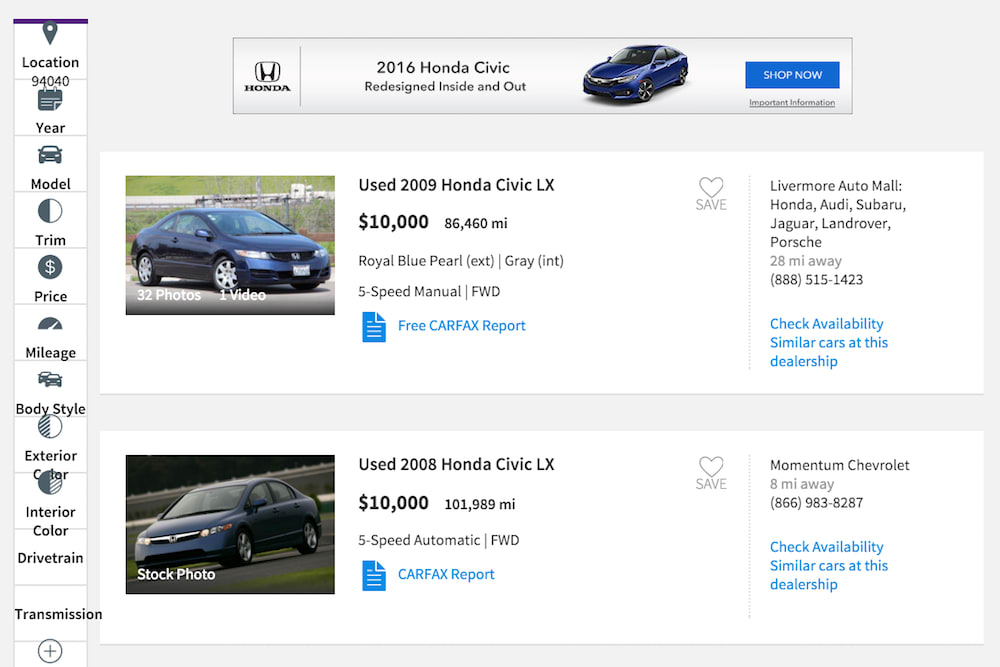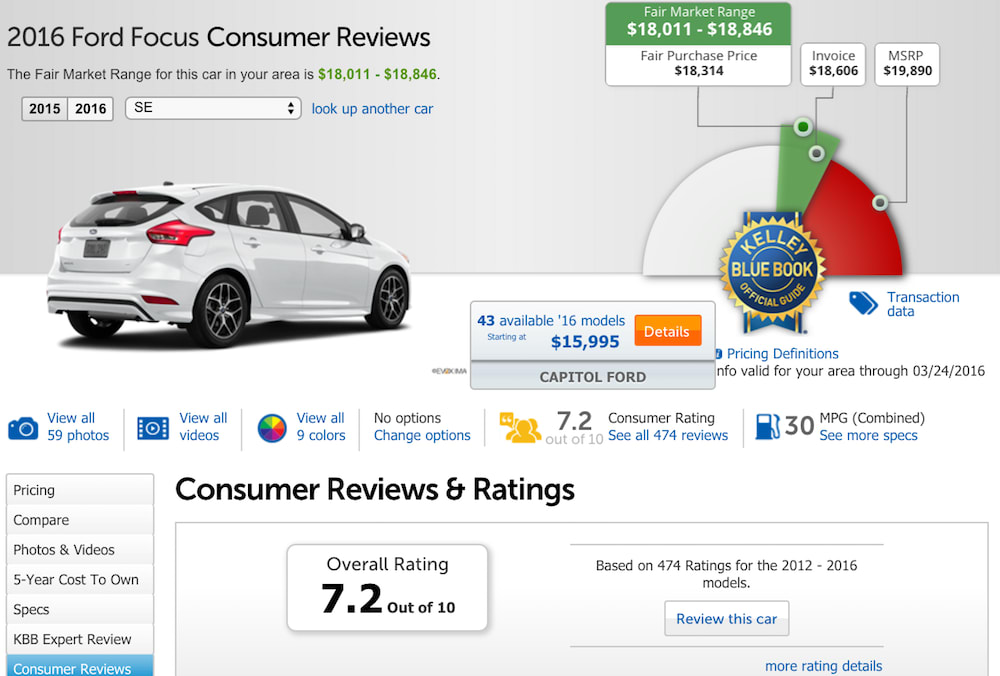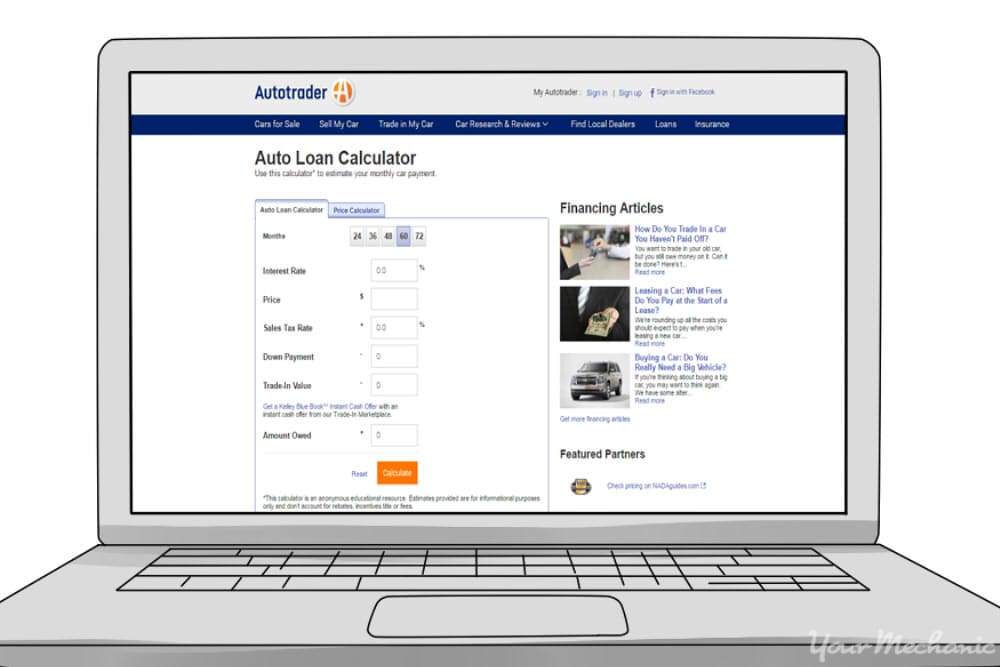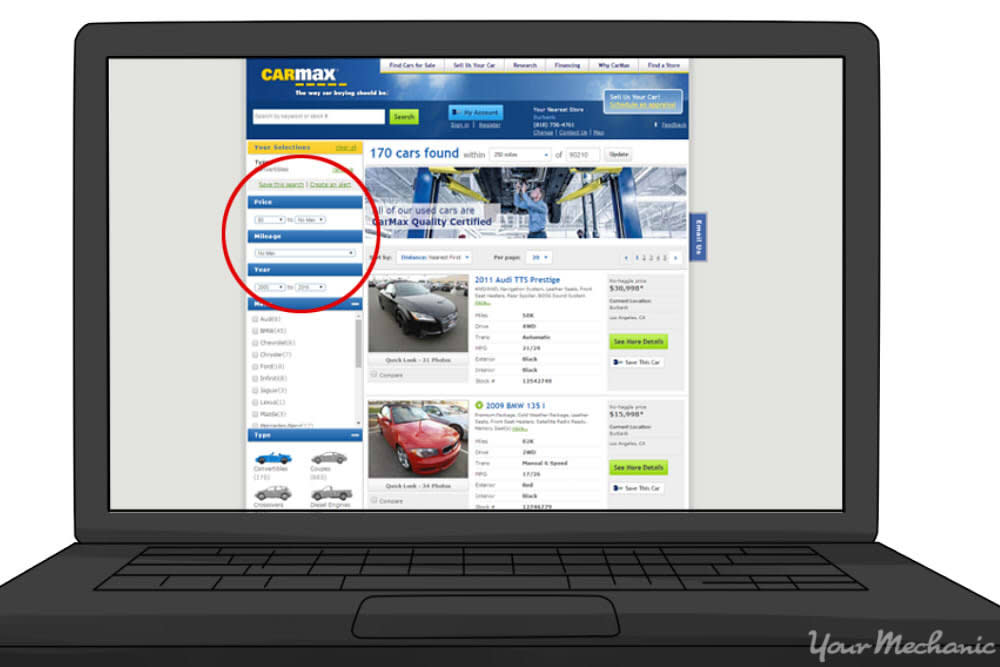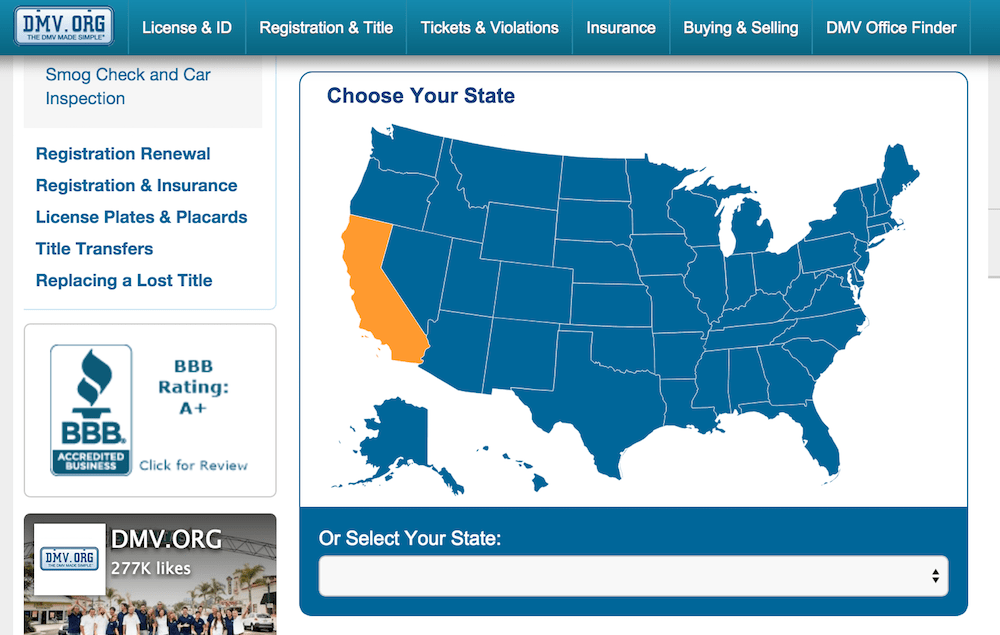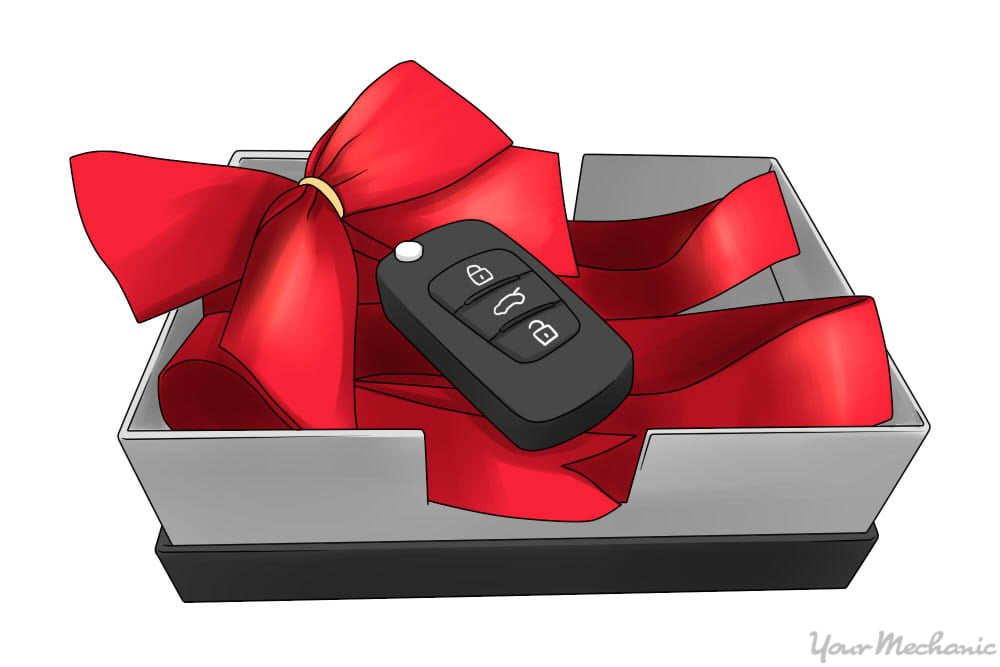

Buying a new car is a big investment, often second only to purchasing a home. It’s important to make the best choice based on your specific financial situation. If you follow some helpful tips, you will make an informed decision, allowing you to be confident with your selection.
Part 1 of 7: Decide what type of vehicle you want
The first step in a new car purchase is deciding the exact vehicle make, model, year, and trim level you want. You also need to think about what features are most important to you in a vehicle.
Step 1: Search for vehicles. Search for cars that check all your boxes. For instance, if you need seating for six or seven people, you would look at either a mini-van or a larger SUV. You can visit a site such as Cars.com and use its vehicle comparison tool to compare different vehicle makes and models.
Step 2: Narrow down the list. Find the models with the most features that fit your needs. While you may not get everything you want, you should look for something that meets most of the requirements.
- Tip: One often overlooked area is cargo space. Make sure to pop the trunk or hatch to see how much cargo space the vehicle actually has and if it will be sufficient.
Step 3: Read reviews from trusted sources. There are expert and consumer reviews on the Kelley Blue Book and Edmunds websites that are very helpful. These sites give the pros and cons for each vehicle.
Step 4: Compare different models. Compare two or three models you like best to see which one has the most to offer.
Some buyers focus on one aspect of a vehicle, such as the exterior color, while others make another component their top priority, such as safety features.
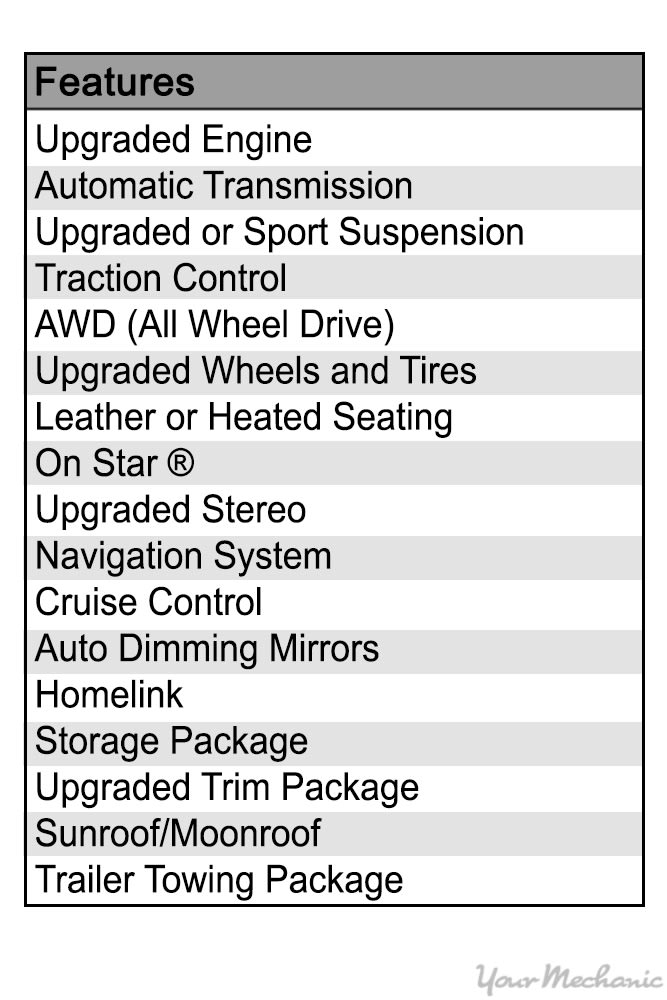
Part 2 of 7: Know what you can afford
Step 1: Know your budget. Calculate your budget to know how much you can afford in monthly payments.
This is an important step to ensure you don’t overextend yourself financially even if you qualify for higher payments.
- Tip: You can find a variety of sites online that offer calculators to help you figure out how much your car payments will be, including trade-in value and annual interest rate. Some sites to use include AutoTrader.com, Cars.com, and CarMax.
Part 3 of 7: Find a lender and get pre-approved
After you have determined the budget for your vehicle purchase, it is time to find a lender. Getting a loan amount pre-approved lets you know how much you qualify for so that when you visit the dealership, you have an idea if you can afford a specific vehicle according to how much it costs.
Step 1: Find a lender. Compare rates and terms with several lenders and select the one that offers the best option.
- Tip: It is also a good idea to know what your credit score is before talking to a lender. Your credit score helps to determine what kind of annual percentage rate, also known as the interest rate, that you qualify for.
A good credit rating means you can get a lower overall rate, paying less money over the duration of the loan.
You can check your credit online for free using Credit Karma.
Step 2: Apply for a loan. Apply for a loan and get a notice of approval. This lets you know what kind of price range you can look at for new vehicles.
Step 3: Know your trade-in value. Figure the value of your trade-in, if you have one. Add that amount to the loan amount you were approved for to see the maximum you can spend on a new car.
You can find out how much your car is worth on the Kelley Blue Book site.
Part 4 of 7: Find a dealer
Once you know what model you want to purchase and how much you can afford, find a dealer for the vehicle type you want to buy. You should also keep in mind the best times to buy a new car to get the best price. Most car dealers are looking to get rid of the previous year's model to make room for the next year closer to the late summer or early fall. Some other good times to buy include at the end of the month or at the end of the year if you are looking to buy cheaper vehicles.
Step 1: Compare dealers. Look up and compare dealers according to their incentives, special offers, and discounts. Select the one that has the best final pricing.
Step 2: Visit the dealership. Go in person to the dealership (or dealerships) you choose.
Part 5 of 7: Test drive the car
Step 1: Take the car for a test drive. While test driving the vehicle, assess whether the vehicle is comfortable to drive and a good fit for you and your family.
You should also test it in the driving conditions you expect to encounter on a typical day. For example, if you drive up and down a lot of hills, test drive it on hills to make sure it has the power and handling you need.
Test drive checklist for new cars:
Before the test drive:
Do your research. Check for available car reviews on such sites as Edmunds.com to learn more about the vehicle(s) you will be test driving.
Check out the body for damage. Just because the vehicle is new doesn’t mean it hasn’t already been damaged. Look for dents, dings, scratches, and rust. Check the windshield for any cracks.
Check out the condition of the tires. Look at the condition of the rubber (is it cracked?) and if the tires all the same make and in similar condition.
Check the vehicle interior for tears or rips in the seams of the fabric.
When the engine is cool, check all fluid levels to ensure they are properly topped off.
Check for leaks with the engine on and off. Look under the vehicle and check for any leaks on the ground. Again, even new vehicles may have problems and it’s best to catch them before the purchase is made.
Make sure everything works. Now is the time to have some fun. Open and close each door, window, and storage compartment. Check that all seat belts work. Check that all door locks work. Turn on and off all lights. Test headlights, tail lights, brake lights, and turn signals. Move the front seats forward and back. If applicable, move or fold-down rear seats. Turn on and off the heater/air conditioner. Ensure the alarm (if applicable) is operable.
Check that the radio is operable. If it utilizes bluetooth, check that it works with your mobile devices.
Listen to the vehicle. Start the engine and listen for any abnormal noises, including hisses, ticks, knocks, or rattles. A new vehicle should start up and run smoothly.
During the drive:
Continue to listen to the vehicle while driving. Listen for any abnormal sounds that may develop during the test drive, including rattles or hisses.
Check that all of the gauges are in working order. It is recommended to have someone else drive the vehicle for a short period of time so that you can safely check that the gauges are in working order. Most modern vehicles have a user interface for vehicle settings and options; take some time to go through this menu and test options provided.
Drive the vehicle above 45 mph, or faster as local speed limit laws permit. Some vehicle problems are only apparent at higher speeds. Does the vehicle stay on path or pull to one side while driving or accelerating? Does the steering wheel shake or vibrate as speeds increase or when braking?
Check the brakes. Is there a squeaking or screeching sound or do they feel “soft” when applying pressure? Does the vehicle stop quickly and completely? Does the vehicle pull to one side when braking? Does the anti-lock braking system (ABS) work when the brakes are applied quickly? If possible, test that the emergency brake will “hold” on a hill.
Feel out the transmission. Is the vehicle shifting smoothly through all gears, up and down? If a manual, does the gear shift or clutch “stick” abnormally when shifting through gears?
After the drive:
With the engine turned on, use your sense of smell. Exit the vehicle and look for any smoke from the engine or exhaust. Also check for any burning smells, which could be the sign of a potential issue.
Check again for leaks with the engine turned on and off. Look under the vehicle and check for any leaks on the ground that may have become visible after the drive.
Remember, if you want a professional to test drive a new car for you, check out YourMechanic’s pre-purchase inspection service for any help and information you may need.
Part 6 of 7: Negotiate pricing
With most new vehicles, you’ll discover room for price negotiation. Take advantage of this fact to get the best deal. You can also research the price of other, comparable vehicles in your area. You can then use that as a bargaining tool to try and get the dealer to reduce the price.
Step 1: Print the list of prices. With the fair market values you gathered from sites like Kelley Blue Book and Edmunds in mind, it is time to negotiate the price for the vehicle you are interested in. Also, take the prices you found at other area dealers with you so you can bargain with the dealer.
Step 2: Start low. Mention the lowest price to the dealership of your choice and let them know you’ll buy from them if they match the price.
If they initially refuse, tell them you have to think about it and leave. The next day, return and tell them that you do not accept their price. At this time, they may reconsider your offer.
Step 3: Know the fees. Once you get a price that you agree upon, make sure to review the fees and charges, and make sure nothing has been charged twice or listed in error.
- Tip. Wait until the dealer has agreed to the price of the vehicle before you mention any trade-ins.
Part 7 of 7: Complete the deal
The last part of buying a new car is to sign all of the necessary paperwork. Some additional items that you need to take care of include adding the vehicle to your insurance, registering the vehicle, and paying any taxes.
Step 1: Choose your options. Decide on which options you want, such as an extended warranty or GAP insurance coverage (the difference between the value of the car and the balance still owed in financing).
Keep in mind that this adds to the overall cost of the vehicle, so work that into your initial budget.
Step 2: Sign the paperwork. Read through the bill of sale and contract one more time to make sure everything is correct. Once you are satisfied, sign the paperwork.
Step 3: Organize your insurance. Alert your insurance company to either a change in vehicle or to add it to your current policy.
You also need to purchase GAP insurance to cover you until your vehicle is covered. This is usually offered by the dealership for a small fee.
The dealership should also make you out some temporary tags to display until you can get your vehicle registered and put on a license plate.
Step 4: Register your vehicle. Register the car and pay sales tax with the state Department of Motor Vehicles. The lender will hold onto the vehicle title until you have paid it off.
Buying a new car is a big decision, and making sure that you get the best price is important. Once you have purchased a new vehicle, it is important that you stick to the maintenance schedule recommended by the manufacturer. This includes having it checked and maintained regularly, either at the dealership, or by a trusted mechanic.


